Fujifilm Fujinon Techno-Stabi TS16x28WP binocular review: practical improvements for outdoor adventures
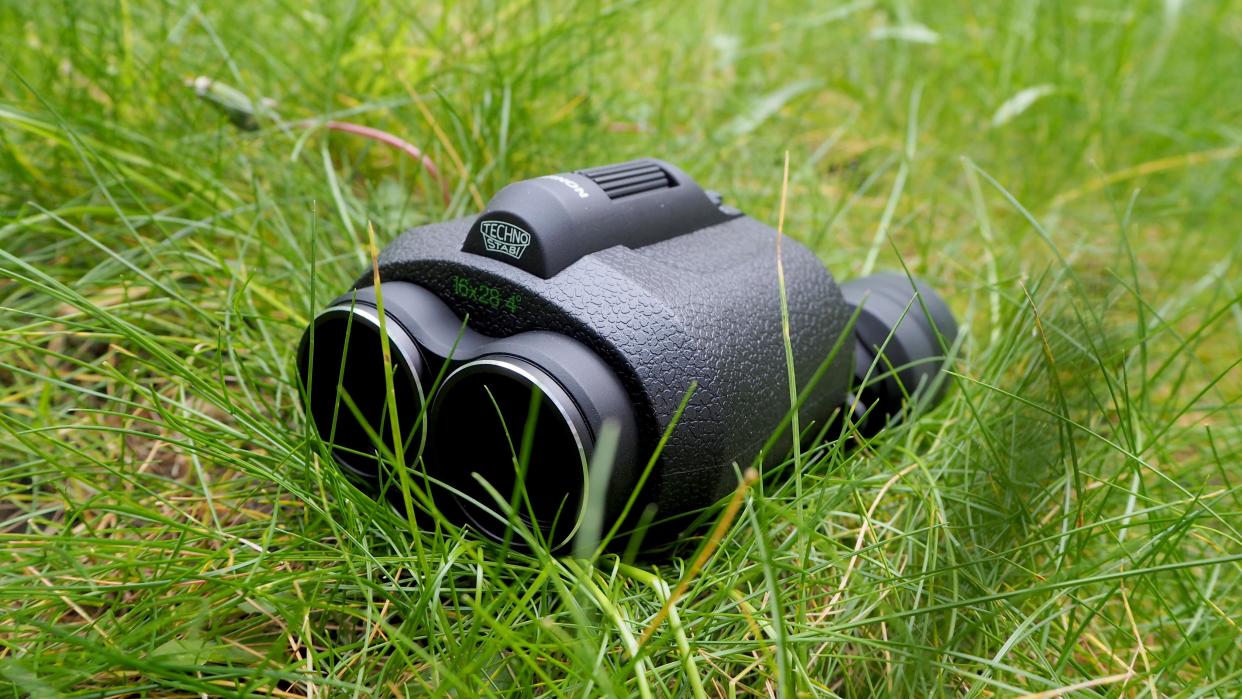
Jump to:
Specifications
Key features
Design & Handling
Performance
Verdict
Alternatives
Nature lovers and sports fans have to be prepared to endure all weather in pursuit of their passion. And, if they’re considering a binocular to be able to provide better observation from afar, then seeking out a waterproofed, or at least weather-resistant, device is a must.
Enter the Fujifilm Fujinon Techno-Stabi TS16x28WP binocular, the new addition of ‘WP’ to the model name indicating its waterproofed body. Why ‘Techno-Stabi’? Well, when we discover ‘Stabi’ translates as Stabilizer in Japanese, it makes more sense. Especially when here we have a generous 16x magnification, coupled with an adequate if seemingly less generous 28mm objective lens. When using the device handheld, some form of built-in anti-shake is going to be beneficial.
As ever, it’s about finding that sweet spot; a specification that offers sufficient magnification to appeal to wildlife watchers, nature lovers, and sports fans, without us ending up with a bulky and weighty observation device because of it. Just like with cameras, the best tool for the job is the one you have with you, so when it comes to binoculars for all but the most specialist tasks, portability is just as important as performance. The Fujifilm Fujinon Techno-Stabi TS16x28WP is compact enough to just about squeeze into a roomy jacket pocket, or indeed a small rucksack.
But what about its performance, which is after all the real reason we’re buying a binocular? Has its high magnification ended up giving us too narrow a field of view, or has Fujifilm got the balance just right? Read on to find out…
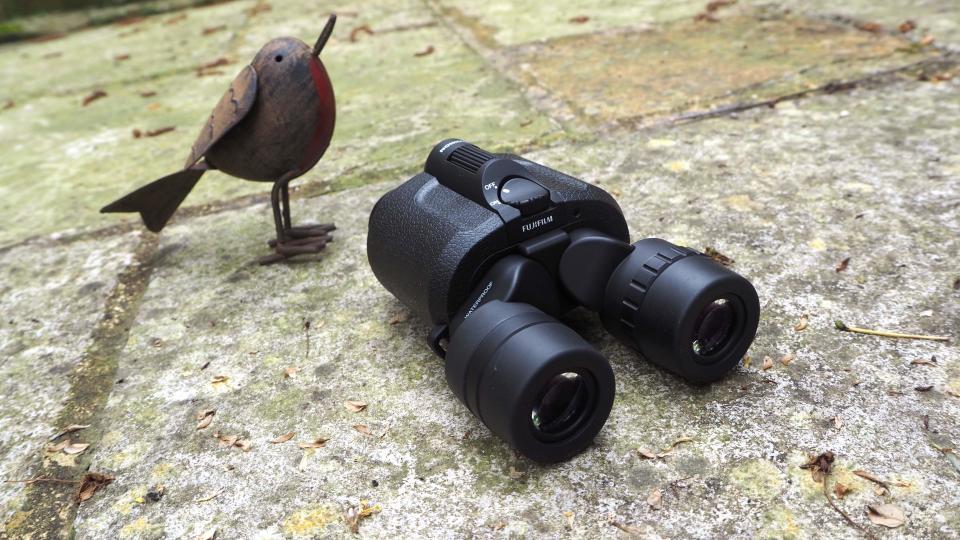
Fujinon Techno-Stabi TS16x28WP: Specifications
Fujinon Techno-Stabi TS16x28WP: Key features
Field of view aside for a moment, the higher the magnification, the more chance there is of visible image judder and our subject appearing to wobble about when using the binoculars handheld. Any small tremor in our own hands is magnified and will be noticeable at 16xcular. A way around this is to mount the binocular on a tripod if there’s a built-in screw thread to enable us to do this – but here there isn’t.
Less fussy perhaps is simply to opt for a binocular that has body integral anti-shake to compensate, negating the need for a tripod. While image stabilization is still relatively rare in the binocular world, and Canon has enjoyed a virtual monopoly on anti-shake binos for years, Fuji’s Fujinon Techno-Stabi TS16x28WP binocular puts such a feature front and center in the model name.
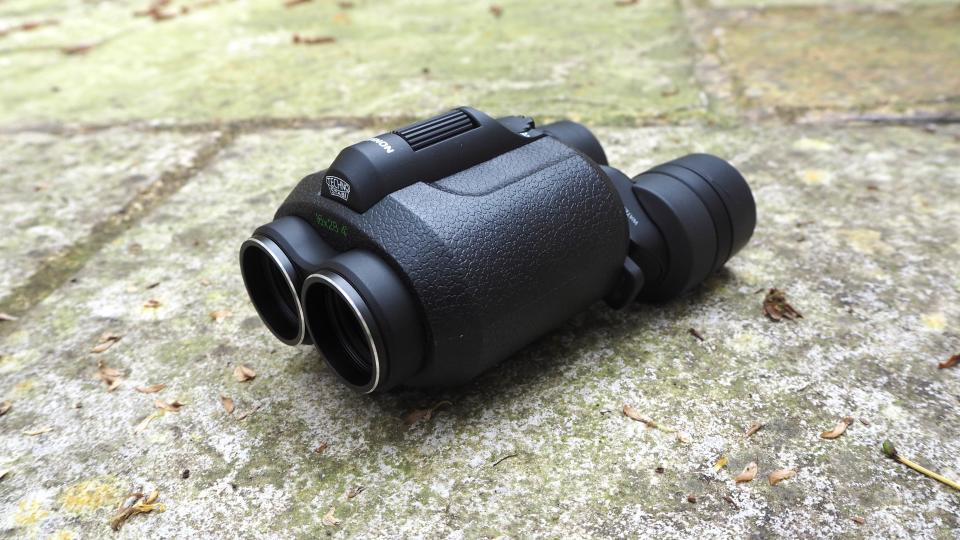
Of course, we’re expected to pay a premium over a standard purely analog binocular for having such compensatory technology built in. But for those engaged in regular, longer periods of observation, especially when observing skittish subjects, the extra investment could be well worth it.
Apart from image stabilization, which here requires the insertion of a removable CR2 lithium battery between the front optics to power the feature, another key selling point is that the device is waterproof to IPX7 standard. This translates as it being able to survive being dunked for a half hour in water a meter deep, with theoretically, no ingress of moisture. So it’s more for protection against accidental drops, or providing us with reassurance if using it out in the rain, than deliberately wading into the ocean with it.
Fujinon Techno-Stabi TS16x28WP: Design & Handling
As a belt to the ‘braces’ of the built-in image stabilization, the Fujifilm Fujinon Techno-Stabi TS16x28WP binocular boasts a non-slip embossed leather-like coating to its surface, providing the ability to gain a firm grip when in use. But what most impressed us is how compact these binoculars are, when compared with bulbous image-stabilized alternatives from the likes of Canon.
The binocular design is also slightly unusual – having an almost frog-like look, with the eyepieces jutting outwards from the body at a leg-like angle when fully extended. In practice, this is so we can adjust the inter-pupillary distance of the latter to marry up with our own eyes for comfortable viewing. Here the range for adjustment is between 55-70mm. Additionally, the big round lenses at the front – so close together that they’re almost touching each other – anthropomorphically resemble a pair of eyes.
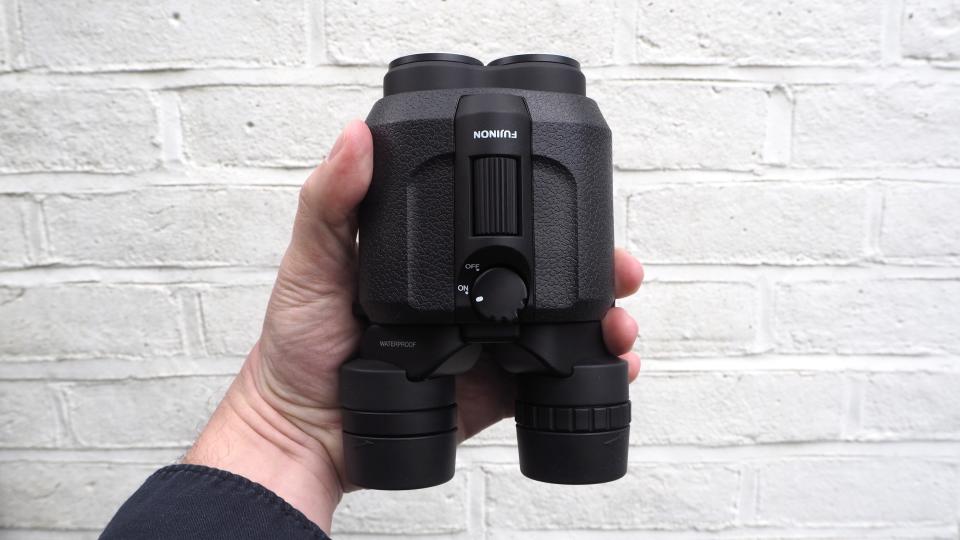
Because they are positioned so close together there are no protective lens caps provided; we just get the standard slip-on rubber caps to instead protect the eyepieces. Unfortunately ‘slip-on’ means they’re just as easy to slip off, as there’s no means of tethering them to the strap to prevent possible loss. For further comfort, the eyecups themselves are of the twist-up variety and there’s a very stiff feel dioptric adjustment wheel encircling the right eyepiece, allowing for further fine-tuning if required.
If 16x magnification seems a bit too much, then take note of the fact there’s an outwardly identical-looking Fujinon Techno-Stabi TS12x28WP model released alongside this one. A less ambitious 12x magnification makes it just a smidgeon lighter at 485g without battery compared with the 16x28 alternative’s still very manageable 550g. That’s fully half the weight of the much more expensive Swarovski AX Visio 10x32 binocular we recently reviewed.
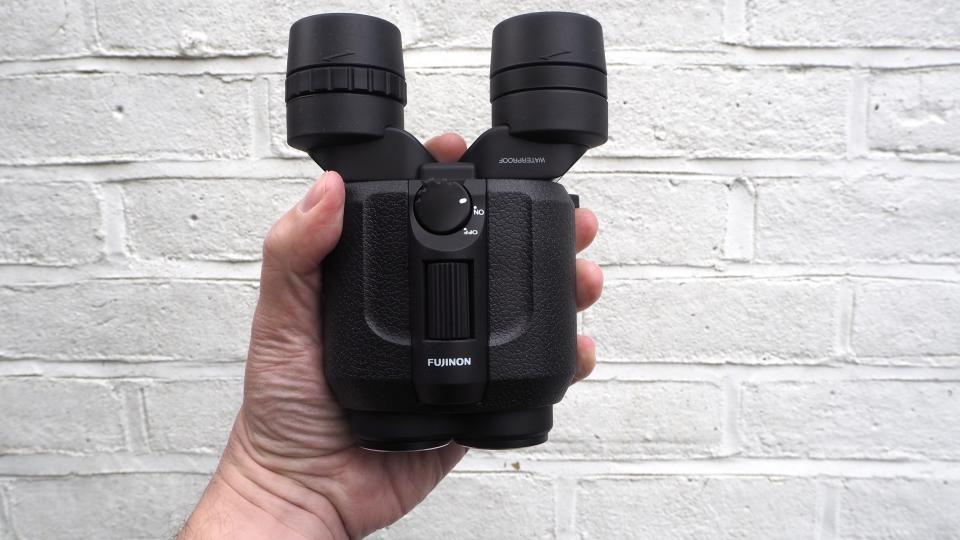
With the battery power required for this Fuji’s built-in anti-shake feature, we’re told up to a very generous 30 hours of use can be had from just one CR2 lithium cell. In terms of the built-in IS, this has an automatic switch-off function after 10 minutes, to preserve battery life.
Temperature can of course affect performance, yet here operating temperature is from a standard -10°C up to 50°C.
It’s worth mentioning that, while anyone who is considering this binocular will be doing so as an alternative to Canon’s own IS binos, there is no screw thread for tripod mounting provided on this Fuji. Not an issue for us as we found it possible to get relatively steady, judder-free views without the IS activated – though as we’ll see, having the image stabilization feature is a definite advantage over not having it.
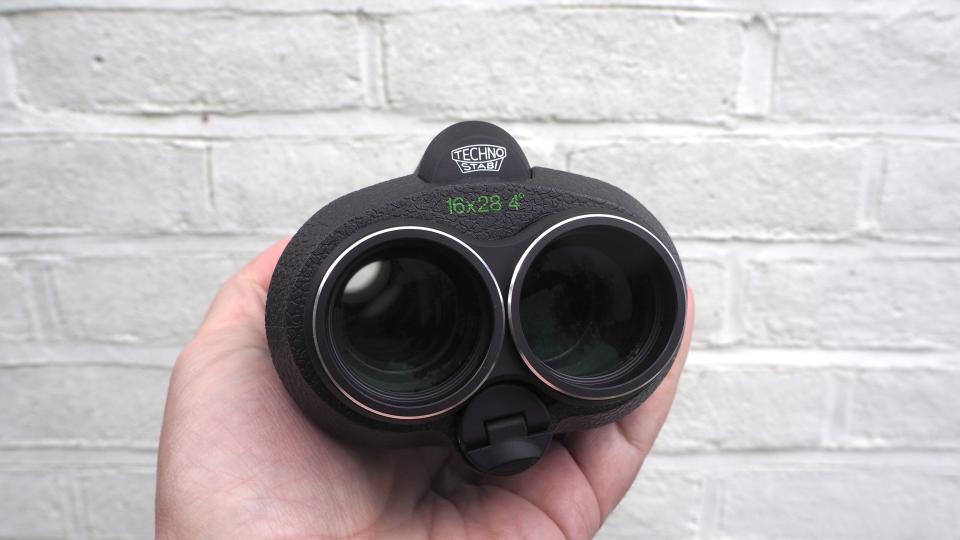
Fujinon Techno-Stabi TS16x28WP: Performance
Compact and portable despite the magnification range on offer, once we’ve inserted the CR2 battery for the stabilization feature, we can begin using these Fujinon Techno-Stabi TS16x28WP binoculars straight out of the box. Operation is intuitive and immersive, with a large ridged focus wheel located on the upper top of the body, while an equally large and obvious dial is provided for activating or de-activating the body integral IS. This is instead of the usual small recessed button found on Canon alternatives.
As turning the stiff dial on the Fuji is a definite act, requiring a flick of the thumb, we feel it’s less likely that they’ll be accidentally activated in the act of retrieving them from, or placing them back in, a jacket pocket or carry pouch.
The compact size and ergonomic design also mean that, once we’ve adjusted the eyepieces to provide a comfortable match for our own eyes, it’s perfectly possible to operate these with a single hand, especially with ‘IS’ activated. In practice though we found ourselves automatically using both hands, in order to better steady and more precisely center our viewing.
The minimum focus distance is 3.5 meters, the same as for its smaller brother, the Fujinon Techno-Stabi TS12x28WP. Much is made of the fact that phase-coated prisms here can provide the viewer with not only a sharp but a high-contrast image, all the better for picking out distinctive markings on animals and wildfowl. Multi-coated optics are, just like every binocular, an aid to boosting light transmission though as light falls at the end of the day, the view we got was noticeably dimmer than when the sun was directly overhead at lunchtime.
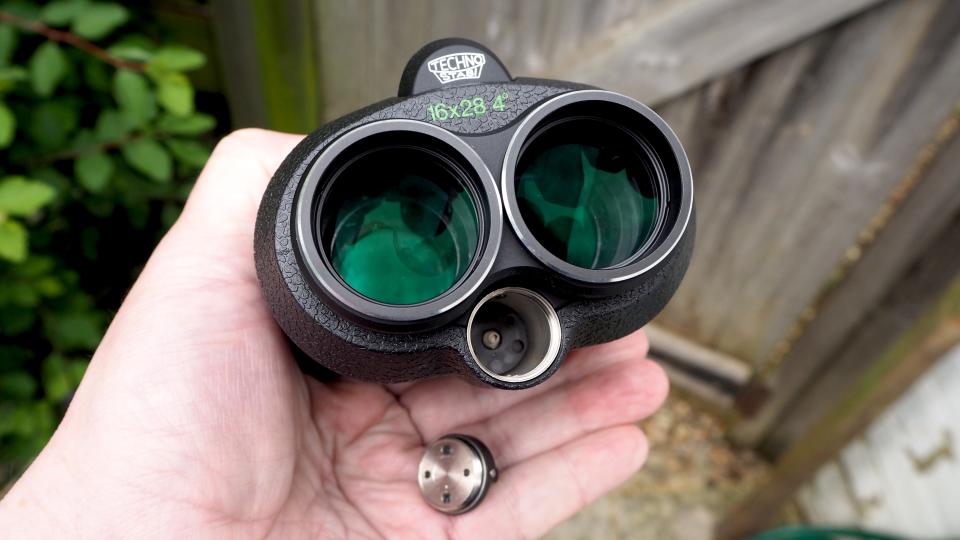
In practice, the focus wheel, dioptric adjustment ring, and IS dial are all a little stiff to the touch, but on the plus side, this allows for precise adjustments as opposed to accidental ones. The binoculars, because of the high-ish magnification, do however present quite a narrow field of view. If trying to track moving wildlife we found it tricky to keep them within our field of view without lifting the binoculars from our face, re-locating the subject, and then attempting to re-frame. For fairly static subjects, viewed when sightseeing or traveling, this is obviously less of an issue – or we can simply step back. But try keeping up with smaller subjects like squirrels darting about and we quickly lose them.
While as noted earlier it’s perfectly possible to hand-hold the binoculars and get acceptable results with a minimal amount of visible judder, flicking the dedicated image stabilization dial makes for a visibly smoother and more comfortable experience. Where once subjects may have appeared a little jittery, they now gracefully glide. In this way, when observing wildlife we were able to take note of finer details such as distinctive feather markings and eye colour. Our viewing was also commendably free of chromatic aberration/color fringing when viewing high-contrast scenes, such as where the dark leaves of a tree met the clear blue of the sky.
Fujinon Techno-Stabi TS16x28WP: Verdict
What we’re getting with the high-tech-looking Fujinon Techno-Stabi TS16x28WP is a solid-feeling pair of waterproofed image-stabilized binoculars that are nevertheless no bigger or heavier than a regular non-IS binocular. Build quality is impressive, they feel good in the hand, plus the design is compact and practical. Activating the image stabilisation feature does also make a visible difference and for a more comfortable viewing experience overall.
The only gripes we can level at this device is that the view provided is not as bright or as razor sharp as more expensive alternatives. Plus the relatively narrow field of view due to 16x magnification can be occasionally frustrating when we’re trying to pinpoint and track wildlife.
Price-wise, while these are expensive because of the on-board technology – and pretty much identical in terms of UK Sterling and US dollars at the time of writing – they don’t feel prohibitively costly when compared with Canon alternatives. They’re also much more affordable than brighter and sharper competitors from Leica or Swarovski, so a purchase decision needs to be made with those caveats in mind.
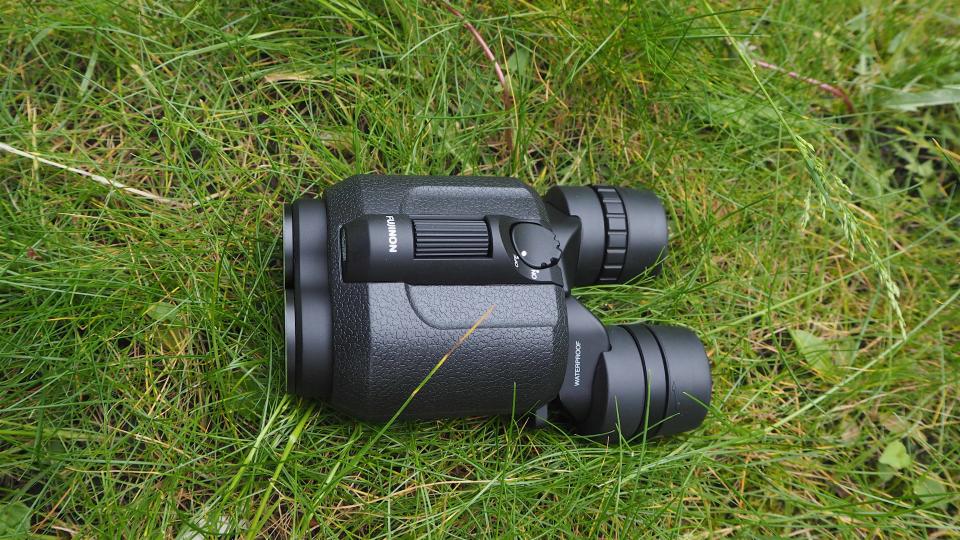
Alternatives
We came to the Fujifilm Fujinon Techno-Stabi TS16x28WP directly after having used the Swarovski AX Visio 10x32, so were a little spoilt. In terms of sharpness and light transmission, the Swarovski is clearly in a league of its own. A closer comparison to the Fuji is therefore the image-stabilized binocular offerings from Canon, which have pretty much ruled the roost for anyone wanting built-in ‘IS’ until now.
A starter option from the range is the bulbous-looking, similarly battery-powered Canon 8x20 IS, the compromise – and here it feels like a bigger compromise than our present Fuji company – being a slightly bigger binocular than a bog standard non-IS incorporating 8x20 specification model. Also, at this relatively modest magnification, we may not arguably need ‘IS’ under the majority of circumstances, so can save ourselves from paying the premium price being asked.
A closer competitor to our example would be the Canon 12x36 IS III, marrying a decent 12x magnification – that may seem on paper a little underpowered when compared to the 16x Fuji, but in reality isn’t noticeably so – to a brighter 36mm objective lens.
A 12x magnification is also sufficiently powerful that we readily notice when the ‘IS’ feature kicks in, as formerly juddering subjects are replaced by perfectly smooth views. Powered by two AAs, we felt this Canon to be a well-balanced product when we tested it, no pun intended.
As ever, whether you can justify the additional outlay asked for an image-stabilized binocular comes down to whether you expect to be hand-holding them for prolonged periods.

